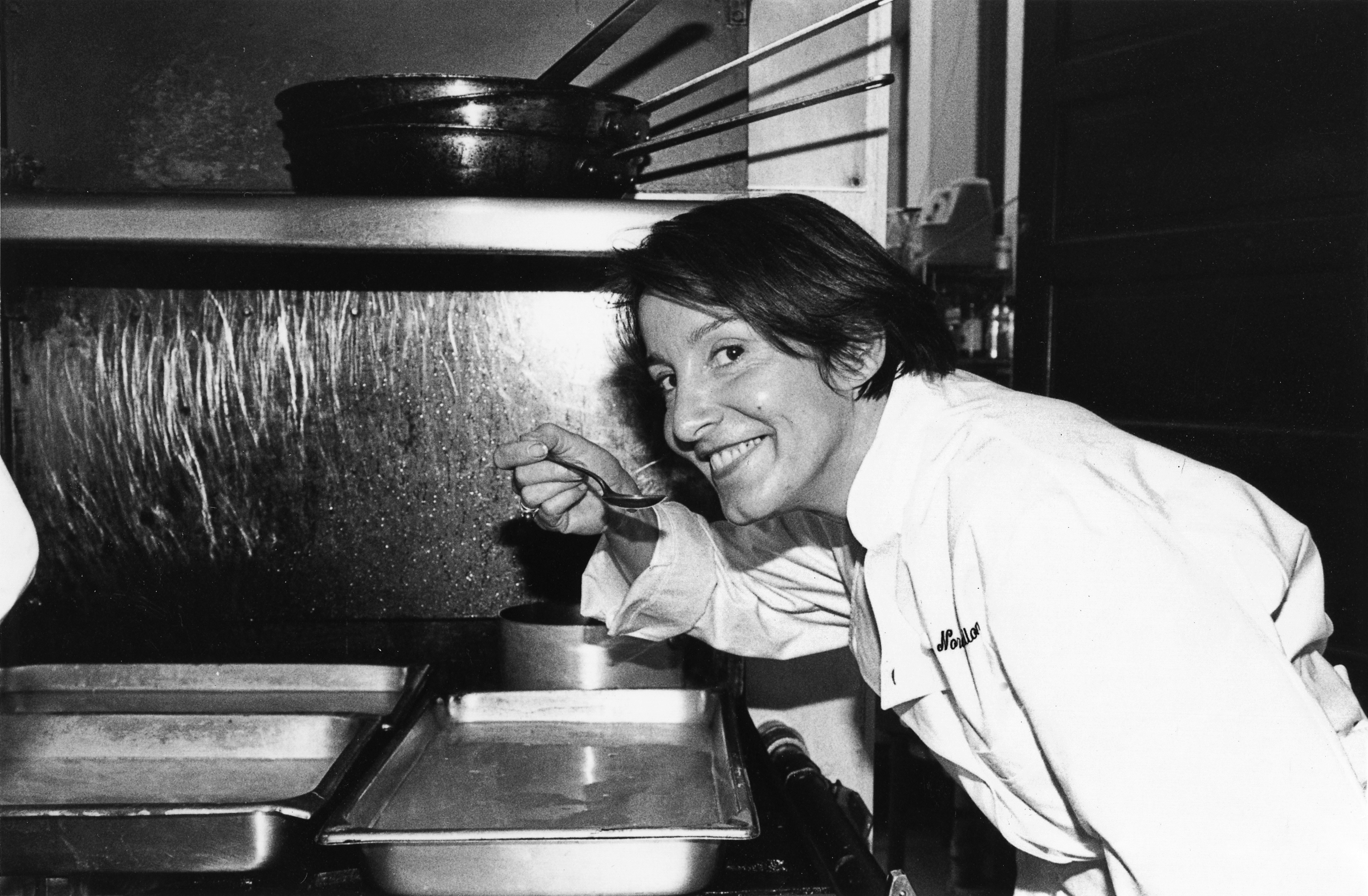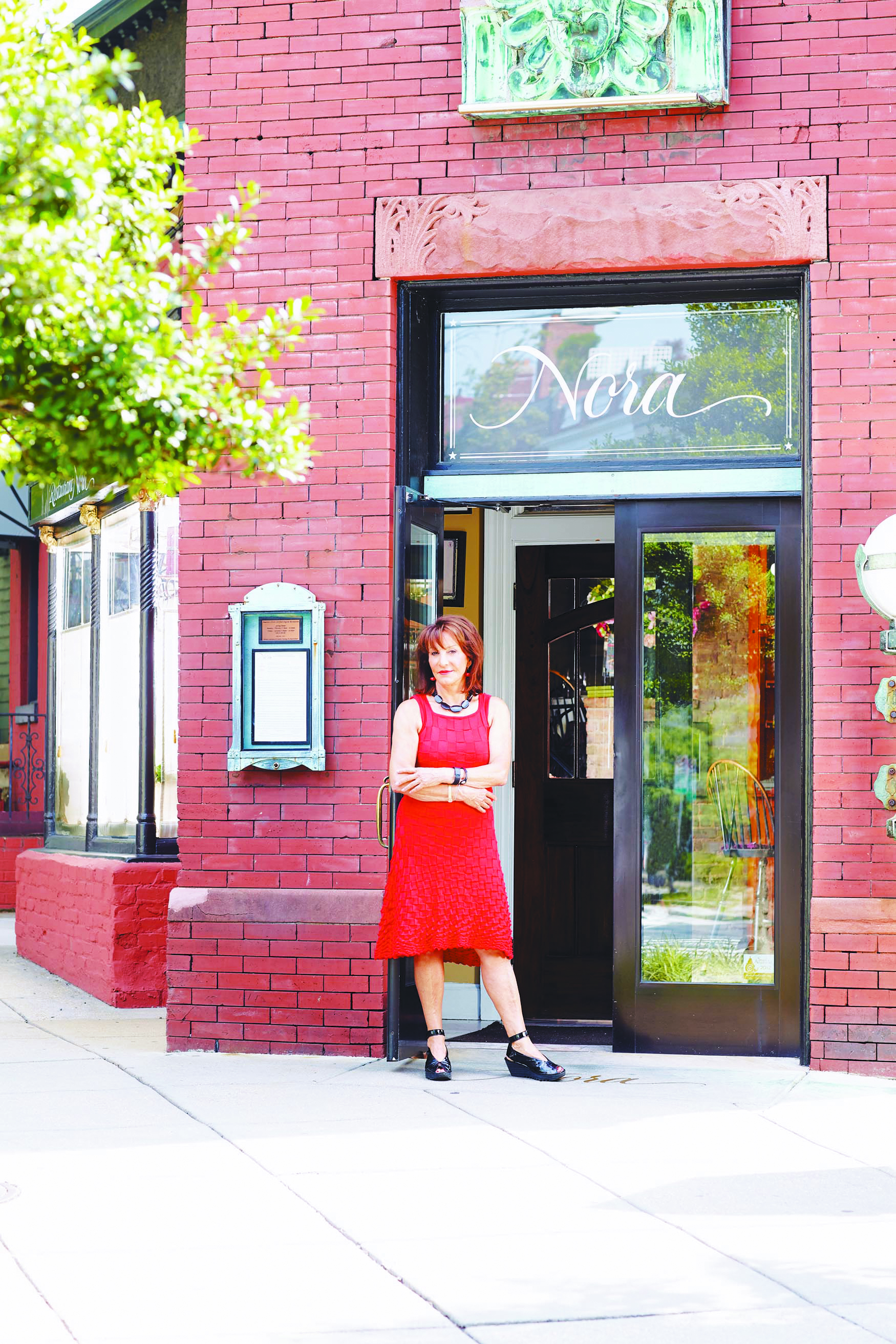At first glance, chefs Maria Hines and Nora Pouillon couldn’t seem more different. Hines is wearing jeans, a black long-sleeved T-shirt and clogs, her signature thick black braid falling efficiently down her back, her face devoid of makeup. Pouillon has on a chic fitted leather jacket over a floral dress, black tights, and a silky red scarf at her neck. Her lips are bright red, her hair perfectly coiffed. It’s a no-brainer as to who’s repping the East Coast and who’s from the West.
Their backgrounds are wildly dissimilar as well. Hines grew up in the San Diego suburbs in the ’70s, while Pouillon is an Austrian war child. But the two women do share one extraordinary similarity: They are the first chefs in the U.S.to open certified organic restaurants—Pouillon’s Restaurant Nora in Washington, D.C., in 1979 and Hine’s Tilth in Seattle in 2006. In honor of Pouillon’s recent publication of My Organic Life: How a Pioneering Chef Helped Shape the Way We Eat Today (Knopf, $26.95), Hines hosted a dinner at Tilth last week, during which Pouillon spoke and signed copies of her memoir. As the kitchen began buzzing in preparation, I managed to get both of them in a room together for a bit to talk about their great achievements, the challenges they’ve faced along the way, and why they’re both so committed to “clean” eating.
SW:
Maria, Nora writes very candidly about what drove her to the organic side. A young bride fresh from Europe in the ’60s, she was horrified when she set first foot in an American supermarket, with its anemic vegetables and canned and packaged everything. She also had a life-changing conversation with a farmer who extolled the virtues of feeding her cows corn rather than grass and pumping them up with antibiotics. Did you have an “aha” moment too?
Hines: Yeah, I grew up thinking that food came from supermarkets. Birds Eye vegetables, canned green beans. I didn’t know there was more than one kind of peach. At 18, my mentor chef took me to Rancho Santa Fe in San Diego, a little farmstand, and we walked the field and I ate a raw piece of white corn. It tasted like a candy bar! The crunchy texture, that sweet juice running down your chin. I was like, “Holy shit. This is food.”
After that, I spent a few months in France working at a one-star Michelin restaurant where the owner came in with food from the market, the fish guy came in off the boat in rubber boots, and the chef’s sister brought vegetables she grew herself. The carrots still had dirt on them! This was pivotal because I was used to vendors coming to us. Farmers markets didn’t exist in San Diego at that time.
Nora, your childhood was quite different, right?
Pouillon: Yes, because we were so close to Italy, Yugoslavia, and France, I was exposed to very simple foods that relied on the integrity of the ingredients. So what I did was cook Mediterranean food.
You were way ahead of the Mediterranean diet fad then. But you faced some challenges in getting people, particularly Washington bureaucrats, to embrace “healthy” food.
Pouillon: Yes, many of them just wanted steak. I had to show them that this wasn’t a special diet, but ingredients that are as close to clean as they can get. I had to convince them that it’s not a “vegetarian, macrame, sprouts, and brown rice” place.
You write in your book that food critics were often hard on you. In particular, then-
Washington Post
critic Phyllis Richman ranted about all the zucchini you served and that Nora wants to “dill us to death.”
Pouillon: I recently found an old note from Bill Moyers which said “To hell with Phyllis.” I might have resented it more if I hadn’t been so successful, which was mostly due to Ben Bradlee [former editor-in-chief of The Washington Post] and his wife.
You were sticking to your guns about seasonal produce, which now seems like a no-brainer, saying you wouldn’t buy organic cherries from Israel if it wasn’t cherry season here. Maria, I imagine you deal with that issue too.
Hines: Yeah, we don’t do it. We sometimes pull from California, but that’s it. It gets hard in winter, especially with pastries: It’s all apples, pears. So we use nuts, do panna cottas, cremes brulees. But, at the same time, there’s so many root vegetables. I call it the six-month root-vegetable season: when there’s parsnips, parsley root, kohlrabi, beets, different types of carrots. And thank God for brassicas! But I think I’m lucky because of living on the West Coast where there’s more social consciousness.
Nora, not only did you have to convince diners, but you literally had to get area farmers on board with growing organic produce. You basically promised them you’d buy all of what they grew for you, correct?
Pouillon: People didn’t understand what I was looking for. It took me time to convince farmers to become certified organic. I had verbal contracts with them: “One cow every two weeks, one lamb every three . . . ”
Besides getting farmers to take you seriously, Nora, you were also faced with the reality that no organic-certification guidelines even existed when you opened Nora. You actually helped create them?
Pouillon: I was trying to find a certification agency, and the only one I found was Oregon Tilth. But they’d never done it for a restaurant, so they had to take standards from farms, stores, and production companies and adapt them to a restaurant. It took two years. And then I had to organize bus trips for chefs to farms, a lot of Mennonite and Amish farms in Pennsylvania. I did that for three years. Most restaurants still just pick up the phone and leave a message with the vendor for what they want.
So, Maria, by the time you applied, it was much easier, I imagine. And I’m also guessing you had a lot of farmers on board.
Hines: Yes, they [Oregon Tilth] walked me through the application process. I chose them because they are one of the most rigorous certifiers in the country. At least 95 percent of everything you serve must be certified organic. The farmers-market explosion hadn’t happened, but I took a farm tour with Charlie’s Produce (who I still use today), and it was like I’d landed inside a treasure chest. Everywhere you look here, you’re looking at your source of food. But I still had to make a lot of relationships with farmers and fishermen, people who’d never sold to restaurants before. I wanted to use cream from Fresh Breeze Cream, but they didn’t have delivery, so I was like, How can we help set them up? I also started buying cows from the Skagit Valley, and had to help those farmers understand the size of cow that chefs wanted to buy.
How much did Nora influence you to get the certification?
Hines: She was a big deal to me. I met her when I was the executive chef of the Seattle W Hotel’s Earth and Ocean restaurant. We were both on the board of Women Chefs and Restauranteurs and we developed a rapport. In 2005, I won Best New Chef from Food & Wine magazine, so I knew if I was ever going to open my own restaurant, now was the time. So I talked to Nora: Should I do it? The biggest thing she taught me was how to keep food costs down. And that was by not using super-luxury items and by having no waste.
Right—in the book Nora talks about how she would use every single part of the cow, to the point where she had so much ground beef that she had to open another restaurant, City Cafe, so she could use it up in burgers, tacos, stuffed peppers, pat
e
s. What’s your memory of Maria starting down the organic path, Nora?
Pouillon: I gave a keynote speech at a conference about how women can have an enormous impact on the health of this country, about how to be more informed on how to make a balanced meal. Maria was there, and I think she heard me talk about how we as women have a lot of power. Women think more about their families; they make decisions about what’s served in their homes. There’s a saying: “The man is the head, but the woman is the neck. But the head can’t do anything without the neck.” Maria called me up and said she wanted to do organic and how do I go about it? I was so happy.
You both are also big advocates for getting healthy food to lower-income families and in school lunches, working with organizations like SNAP [Supplemental Nutrition Assistance Program]. How successful have those efforts been?
Pouillon: I initiated 11 farmers markets in D.C., and six of them have SNAP and EBT [food stamp] programs.
Hines: Yes, and there’s even a “Vegetable Prescription Program” now.
You mean a doctor literally writes you a prescription for organic produce?
Hines: Yes, exactly.
But there’s still a lot of work to be done, yes? Nora, your book says that only one percent of American land is organic, compared to 25 percent in Europe.
Pouillon: It may be two percent now . . . People still don’t make the connection between health and food here. The average person who eats all conventionally raised food ingests 6.6 ounces of pesticides a month [according to a study by Ann Cooper, a huge advocate for healthier school lunches]. But the lobbyists in D.C. are so powerful, not like in the ’60s. The people need to tell the government that we don’t want to get slowly poisoned, to support causes like “Just Label It.”
Do you think Michelle Obama, who you hosted a birthday party for at your restaurant, has helped the cause?
Pouillon: She is great with her work for school lunches and getting gardens attached to schools, but, you know, she does something and they criticize her. She has to do it in a very gentle way.
Your restaurant is popular with the Clintons too, right?
Pouillon: The Clintons, the Obamas, no Republicans.
Neither former President George Bush Sr. or Jr. has eaten at your restaurant?
Pouillon: No. Only Laura Bush, once, with her daughters. Oh, and one time Nancy Reagan came to lunch with Barry Goldwater. She ate half a trout and a salad.





